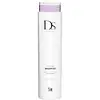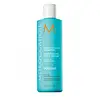What's inside
What's inside
 Key Ingredients
Key Ingredients

No key ingredients
 Benefits
Benefits

 Concerns
Concerns

 Ingredients Side-by-side
Ingredients Side-by-side

Water
Skin ConditioningSodium Lauroyl Sarcosinate
CleansingCocamidopropyl Hydroxysultaine
CleansingDisodium Cocoamphodiacetate
CleansingGlycerin
HumectantSodium Chloride
MaskingCocamide Mea
EmulsifyingPolyquaternium-6
Dimethylpabamidopropyl Laurdimonium Tosylate
Ethylhexyl Methoxycinnamate
UV AbsorberAmodimethicone/Morpholinomethyl Silsesquioxane Copolymer
PEG-150 Pentaerythrityl Tetrastearate
EmulsifyingPEG-6 Caprylic/Capric Glycerides
EmulsifyingTrideceth-5
EmulsifyingPhenoxyethanol
PreservativeIodopropynyl Butylcarbamate
PreservativeLactic Acid
BufferingWater, Sodium Lauroyl Sarcosinate, Cocamidopropyl Hydroxysultaine, Disodium Cocoamphodiacetate, Glycerin, Sodium Chloride, Cocamide Mea, Polyquaternium-6, Dimethylpabamidopropyl Laurdimonium Tosylate, Ethylhexyl Methoxycinnamate, Amodimethicone/Morpholinomethyl Silsesquioxane Copolymer, PEG-150 Pentaerythrityl Tetrastearate, PEG-6 Caprylic/Capric Glycerides, Trideceth-5, Phenoxyethanol, Iodopropynyl Butylcarbamate, Lactic Acid
Water
Skin ConditioningSodium Lauroyl Sarcosinate
CleansingCocamidopropyl Hydroxysultaine
CleansingCocamidopropyl Betaine
CleansingGlycerin
HumectantCocamide Dipa
EmulsifyingPolyquaternium-70
PEG-150 Pentaerythrityl Tetrastearate
EmulsifyingArgania Spinosa Kernel Oil
EmollientTilia Tomentosa Bud Extract
Skin ConditioningChondrus Crispus Extract
Skin ConditioningAscophyllum Nodosum Extract
Skin ConditioningLaminaria Saccharina Extract
Skin ProtectingPalmaria Palmata Extract
Skin ProtectingUndaria Pinnatifida Extract
Skin ConditioningCitric Acid
BufferingTocopherol
AntioxidantRetinyl Palmitate
Skin ConditioningGlycol Distearate
EmollientPEG-6 Caprylic/Capric Glycerides
EmulsifyingDiethylhexyl Syringylidenemalonate
Skin ProtectingCaprylic/Capric Triglyceride
MaskingLaureth-10
EmulsifyingCocamide Mea
EmulsifyingPolysorbate 20
EmulsifyingPEG-20 Glyceryl Laurate
EmulsifyingAcrylates/Palmeth-25 Acrylate Copolymer
Linoleic Acid
CleansingParfum
MaskingDipropylene Glycol
HumectantButylene Glycol
HumectantCaprylyl Glycol
EmollientTetrasodium EDTA
Chlorphenesin
AntimicrobialPhenoxyethanol
PreservativePotassium Sorbate
PreservativeSodium Benzoate
MaskingWater, Sodium Lauroyl Sarcosinate, Cocamidopropyl Hydroxysultaine, Cocamidopropyl Betaine, Glycerin, Cocamide Dipa, Polyquaternium-70, PEG-150 Pentaerythrityl Tetrastearate, Argania Spinosa Kernel Oil, Tilia Tomentosa Bud Extract, Chondrus Crispus Extract, Ascophyllum Nodosum Extract, Laminaria Saccharina Extract, Palmaria Palmata Extract, Undaria Pinnatifida Extract, Citric Acid, Tocopherol, Retinyl Palmitate, Glycol Distearate, PEG-6 Caprylic/Capric Glycerides, Diethylhexyl Syringylidenemalonate, Caprylic/Capric Triglyceride, Laureth-10, Cocamide Mea, Polysorbate 20, PEG-20 Glyceryl Laurate, Acrylates/Palmeth-25 Acrylate Copolymer, Linoleic Acid, Parfum, Dipropylene Glycol, Butylene Glycol, Caprylyl Glycol, Tetrasodium EDTA, Chlorphenesin, Phenoxyethanol, Potassium Sorbate, Sodium Benzoate
 Reviews
Reviews

Ingredients Explained
These ingredients are found in both products.
Ingredients higher up in an ingredient list are typically present in a larger amount.
We don't have a description for Cocamide Mea yet.
Cocamidopropyl Hydroxysultaine is a synthetic cleansing agent, though it is derived from coconut oil.
It is used to enhance the texture of products by boosting lather and thickening the texture. As a cleanser, Cocamidopropyl Hydroxysultaine is mild.
Glycerin is already naturally found in your skin. It helps moisturize and protect your skin.
A study from 2016 found glycerin to be more effective as a humectant than AHAs and hyaluronic acid.
As a humectant, it helps the skin stay hydrated by pulling moisture to your skin. The low molecular weight of glycerin allows it to pull moisture into the deeper layers of your skin.
Hydrated skin improves your skin barrier; Your skin barrier helps protect against irritants and bacteria.
Glycerin has also been found to have antimicrobial and antiviral properties. Due to these properties, glycerin is often used in wound and burn treatments.
In cosmetics, glycerin is usually derived from plants such as soybean or palm. However, it can also be sourced from animals, such as tallow or animal fat.
This ingredient is organic, colorless, odorless, and non-toxic.
Glycerin is the name for this ingredient in American English. British English uses Glycerol/Glycerine.
Learn more about GlycerinPEG-150 Pentaerythrityl Tetrastearate isn't fungal acne safe.
This ingredient is derived from caprylic and capric acids. It is an emulsifier with emollient properties.
According to the manufacturer, it is hydrophilic and soluble in aqueous solutions (water). They also state this ingredient is stable in a medium pH range (~5 - 8).
As an emulsifier, it helps make oils and oil-soluble ingredients more soluble in water.
Learn more about PEG-6 Caprylic/Capric GlyceridesPhenoxyethanol is a preservative that has germicide, antimicrobial, and aromatic properties. Studies show that phenoxyethanol can prevent microbial growth. By itself, it has a scent that is similar to that of a rose.
It's often used in formulations along with Caprylyl Glycol to preserve the shelf life of products.
Sodium Lauroyl Sarcosinate is a cleansing agent and emulsifier. It is a surfactant derived from sarcosine, and a common source is coconut oil.
As a surfactant, Sodium Lauroyl Sarcosinate helps lift dirts, oil, and other molecules to be washed away. In leave-on products, this ingredient is used as an emulsifier. Emulsifier help prevent ingredients such as oils and waters from separating.
Sodium Lauroyl Sarcosinate is also commonly found as a foaming agent in shampoo, toothpaste, and shaving foam. It is amphiphilic, meaning it loves both water and fats.
Learn more about Sodium Lauroyl SarcosinateWater. It's the most common cosmetic ingredient of all. You'll usually see it at the top of ingredient lists, meaning that it makes up the largest part of the product.
So why is it so popular? Water most often acts as a solvent - this means that it helps dissolve other ingredients into the formulation.
You'll also recognize water as that liquid we all need to stay alive. If you see this, drink a glass of water. Stay hydrated!
Learn more about Water